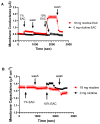E-Cigarette Aerosol Condensate Leads to Impaired Coronary Endothelial Cell Health and Restricted Angiogenesis
- PMID: 37047355
- PMCID: PMC10094580
- DOI: 10.3390/ijms24076378
E-Cigarette Aerosol Condensate Leads to Impaired Coronary Endothelial Cell Health and Restricted Angiogenesis
Abstract
Cardiovascular disease (CVD) is a leading cause of mortality worldwide, with cigarette smoking being a major preventable risk factor. Smoking cessation can be difficult due to the addictive nature of nicotine and the withdrawal symptoms following cessation. Electronic cigarettes (e-Cigs) have emerged as an alternative smoking cessation device, which has been increasingly used by non-smokers; however, the cardiovascular effects surrounding the use of e-Cigs remains unclear. This study aimed to investigate the effects of e-Cig aerosol condensate (EAC) (0 mg and 18 mg nicotine) in vitro on human coronary artery endothelial cells (HCAEC) and in vivo on the cardiovascular system using a mouse model of 'e-vaping'. In vitro results show a decrease in cell viability of HCAEC when exposed to EAC either directly or after exposure to conditioned lung cell media (p < 0.05 vs. control). Reactive oxygen species were increased in HCAEC when exposed to EAC directly or after exposure to conditioned lung cell media (p < 0.0001 vs. control). ICAM-1 protein expression levels were increased after exposure to conditioned lung cell media (18 mg vs. control, p < 0.01). Ex vivo results show an increase in the mRNA levels of anti-angiogenic marker, FKBPL (p < 0.05 vs. sham), and endothelial cell adhesion molecule involved in barrier function, ICAM-1 (p < 0.05 vs. sham) in murine hearts following exposure to electronic cigarette aerosol treatment containing a higher amount of nicotine. Immunohistochemistry also revealed an upregulation of FKBPL and ICAM-1 protein expression levels. This study showed that despite e-Cigs being widely used for tobacco smoking cessation, these can negatively impact endothelial cell health with a potential to lead to the development of cardiovascular disease.
Keywords: atherosclerosis; cardiovascular disease; e-vaping; nicotine; smoking.
Conflict of interest statement
The authors have no relevant financial or non-financial interests to disclose.
Figures







Similar articles
-
E-Cigarette (E-Cig) Liquid Composition and Operational Voltage Define the In Vitro Toxicity of Δ8Tetrahydrocannabinol/Vitamin E Acetate (Δ8THC/VEA) E-Cig Aerosols.Toxicol Sci. 2022 May 26;187(2):279-297. doi: 10.1093/toxsci/kfac047. Toxicol Sci. 2022. PMID: 35478015 Free PMC article.
-
Nicotine and Microvascular Responses in Skeletal Muscle from Acute Exposure to Cigarettes and Vaping.Int J Mol Sci. 2023 Jun 16;24(12):10208. doi: 10.3390/ijms241210208. Int J Mol Sci. 2023. PMID: 37373356 Free PMC article.
-
Modeling Cardiovascular Risks of E-Cigarettes With Human-Induced Pluripotent Stem Cell-Derived Endothelial Cells.J Am Coll Cardiol. 2019 Jun 4;73(21):2722-2737. doi: 10.1016/j.jacc.2019.03.476. J Am Coll Cardiol. 2019. PMID: 31146818 Free PMC article.
-
Early Cardiovascular Risk in E-cigarette Users: the Potential Role of Metals.Curr Environ Health Rep. 2020 Dec;7(4):353-361. doi: 10.1007/s40572-020-00297-y. Epub 2020 Nov 26. Curr Environ Health Rep. 2020. PMID: 33242201 Free PMC article. Review.
-
Comparison impact of cigarettes and e-cigs as lung cancer risk inductor: a narrative review.Eur Rev Med Pharmacol Sci. 2023 Jul;27(13):6301-6318. doi: 10.26355/eurrev_202307_32990. Eur Rev Med Pharmacol Sci. 2023. PMID: 37458647 Review.
Cited by
-
Impact of nicotine-free and nicotine-rich flavored electronic cigarette refill liquids on primary human melanocyte function.Toxicol Rep. 2025 Jan 25;14:101924. doi: 10.1016/j.toxrep.2025.101924. eCollection 2025 Jun. Toxicol Rep. 2025. PMID: 39949971 Free PMC article.
-
A simple, cost-effective, method for creating electronic cigarette vapor condensate.Biol Methods Protoc. 2025 Jul 23;10(1):bpaf055. doi: 10.1093/biomethods/bpaf055. eCollection 2025. Biol Methods Protoc. 2025. PMID: 40799310 Free PMC article.
-
The Impacts of Vaping on the Cardiovascular System: A Systematic Review of Case Reports.Cureus. 2025 Jan 21;17(1):e77780. doi: 10.7759/cureus.77780. eCollection 2025 Jan. Cureus. 2025. PMID: 39981460 Free PMC article. Review.
References
-
- Cardiovascular Diseases. [(accessed on 22 April 2020)]. Available online: https://www.who.int/health-topics/cardiovascular-diseases/#tab=tab_1.
-
- ABS Heart, Stroke and Vascular Disease. [(accessed on 22 April 2020)]; Available online: https://www.abs.gov.au/statistics/health/health-conditions-and-risks/hea...
-
- WHO . WHO Global Report: Mortality Attributable to Tobacco. WHO; Geneva, Switzerland: 2014.
-
- Banks E., Joshy G., Korda R., Stavreski B., Soga K., Egger S., Day C., Clarke N., Lewington S., Lopez A. Tobacco smoking and risk of 36 cardiovascular disease subtypes: Fatal and non-fatal outcomes in a large prospective Australian study. BMC Med. 2019;17:128. doi: 10.1186/s12916-019-1351-4. - DOI - PMC - PubMed
MeSH terms
Substances
LinkOut - more resources
Full Text Sources
Medical
Miscellaneous

